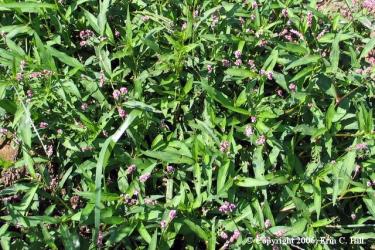Smartweeds (Pennsylvania smartweed and ladysthumb)
Pennsylvania Smartweed and Ladythumb (Polygonum pensylvanicum L. and P. persicaria L.)

Life cycle:
Summer annuals. Emerge in the spring and set seed in late summer/fall and die. There is also a perennial smartweed, swamp smartweed (P. amphimbium L.). The rhizomes are white and thin; hence this weed is often called "shoestring".
Emergence:
Pennsylvania smartweed and ladysthumb (smartweeds) emerge in early in the spring. Ten percent emerge by 150 GDD (base 48 F).
Smartweeds emerge from soil depths of less than 1".
Seed:
Production Average: Each smartweed plant produces an average of 19,500 seeds.
Dispersal Mechanisms: None.
Longevity: Smartwed seed exhibits moderate persistance. It takes 4 years to reduce the seedbank by 50% and about 26 years to reduce it by 99%. In one study, 3% of the smartweed seed still germinated after 10 years. In another study 6% still germinated after 16 years.
Dormancy: Smartweed seed is less dormant when the seed is locate in the upper inch of the soil profile. As burial depth increases, seed dormancy increases. Smartweeds require wet soil conditions to germinate; hot, dry soil conditions cause seed dormancy. Fresh seeds are always dormant and require a cold period (winter) before being able to germinate the following spring.

Competitiveness:
Smartweeds are somewhat competitive, but they are low growing weeds. Soybean yield was reduced 13% by 8 smartweed plants in 30ft^2 of field (about one plant per 4 feet of row). Smartweeds are more competitive in sugar beet.
Preferred Soil / Field Conditions:
Smartweeds prefer wet, poorly drained soils and those high in nitrogen and phophorus. They do not tolerate drought conditions.
Management:
Mechanical
Tillage: Tilling at night (dark tillage) will reduce smartweed emergence by 30-50%. If perennial smartweed is present in the field, clean tillage equipment before moving to another field- the rhizomes will wrap and hang on the tillage equipment.
Rotary hoeing: Hoe smartweeds before they exceed 1/4" in height.
Flaming: Flaming is effective on small smartweeds (less than 1" in height).
Cultural
Crop rotation: Smartweeds are not a weed of small grains and forages.
Planting date: Tilling in the spring triggers smartweed to germinate. Therefore, tilling in early May and planting later (mid-May) will reduce smartweed infestations because many smartweed plants will have emerged and been controlled by tillage.
Chemical
Application timing and effectiveness: Herbicides are available to control smartweeds. Control can be difficult in sugar beets.



 Print
Print Email
Email